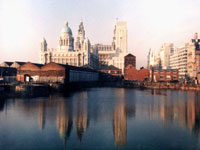Airport
Liverpool John Lennon Airport
IATA Code: LPLLocation: The airport is situated seven miles (11km) southeast of Liverpool.
Time: GMT (GMT +1 between the last Sunday in March and the Saturday before the last Sunday in October).
Contacts: Tel: +44 (0)870 129 8484.
Transfer to the city: Airlink buses operate to the city centre and to local rail and bus stations for further travel. Tickets are £2 and buses leave from the front of the Airport Terminal Building. Garston and Hunts Cross are the nearest rail stations to the Airport serving the local/regional rail network. Liverpool Lime Street services local, regional and mainland services. All have bus links with the Airport. Taxis are also available.
Car rental: Car rental companies include National, Europcar, Hertz, Avis and Enterprise.
Facilities: There are shops, bars and restaurants at the airport. Other facilities include bureaux de change, children's play areas, WiFi and Internet kiosks, business facilities (including fax and internet) and tourist information. Disabled facilities are good; those with special needs should contact their airline in advance.
Parking: Parking can be booked via the airport website.
Departure tax: None.
Website: www.liverpoolairport.com
Visit worldtravels.com for the full guide to Liverpool. Build a complete Liverpool travel guide and email to your clients - sign up for a trial subscription of World Travels Pro.
Liverpool

Whether you take the Ferry 'cross the Mersey, or a stroll down Penny Lane, most visitors will find it difficult to explore Liverpool without a song on their lips. From the twin cathedrals with their striking views over the city to the historical, Grade 1 listed Albert Dock and its Beatles museum, there's plenty to see and do in Liverpool.
An important maritime centre and industrial port, Liverpool was one of the great cities of the United Kingdom in the Industrial Revolution and much of its wealth came from its dominance in the shipping of textiles, cotton, sugar and slaves. The city was severely bombed in World War II and has struggled to get back on its feet, seeing waves of prosperity and depression. The 1960s saw the explosion of the Beatles and pop music, while the 1990s saw an attempt to regenerate the rather dull urban centre.
Liverpool's waterfront is now a UNESCO World Heritage site and the city has achieved World Heritage Status, joining Edinburgh and Bath as the only UK cities to carry the honour. Since the announcement of Liverpool as the European Capital of Culture for 2008, millions of pounds have been poured into further development of the city, including the £920 million Paradise Street development in the city centre.
Liverpool is a city of diversity and despite its struggles, it boasts the most Georgian buildings in the UK, Europe's oldest Chinatown, a number of striking Victorian structures and plenty of world-class attractions. The historical Albert Dock was restored in the 1980s and is now one of the city's most popular attractions, housing chic restaurants, bars, shops and museums, including the Merseyside Maritime Museum and the Tate Liverpool. The city boasts two world-class football clubs, Liverpool and Everton, and fans can explore the grounds of their favourite teams. There is also plenty of Beatlemania to satisfy fans, including the International Beatles Week every August, and several Beatles-related museums and points of interest.
The city plays host to plenty of other events, festival and concerts, as well as the world's biggest steeplechase, the Grand National, at Ainstree. There are also several fascinating museums, beautiful parks and gardens, bustling markets and galleries to explore. Whether a Beatles fan or not, Liverpool has much to offer the visitor and it is no wonder that it has become one of the top UK day trip destinations.







